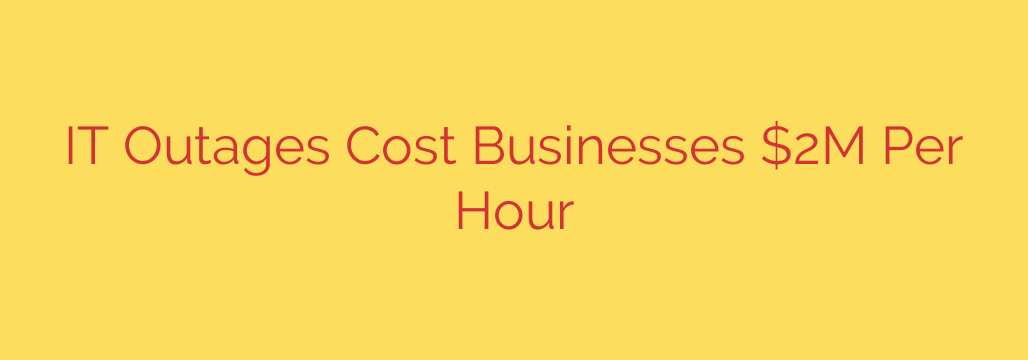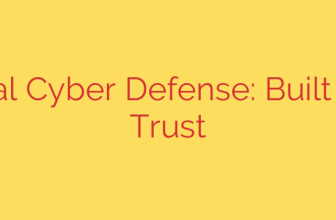
The True Cost of IT Downtime: Why Every Minute Counts
In today’s digital-first world, your business runs on technology. From processing sales and managing customer data to internal communications, every operation relies on a stable and secure IT infrastructure. But what happens when that infrastructure fails? An IT outage is more than just a minor inconvenience—it’s a direct and devastating financial blow.
Recent industry analysis reveals a sobering reality: the average cost of a significant IT outage can reach a staggering $2 million per hour. While this figure includes large enterprises, the principle scales down to businesses of all sizes. For a small or medium-sized business, even an hour of downtime can translate into thousands of dollars in lost revenue, crippling productivity, and long-term damage that isn’t immediately visible on a balance sheet.
Understanding the full financial impact is the first step toward preventing it.
Beyond Lost Sales: The Hidden Costs of an Outage
The immediate loss of revenue is the most obvious consequence of downtime, but it’s merely the tip of the iceberg. To grasp the true cost, you must look at the cascading effects across your entire organization.
Lost Productivity: When systems are down, your employees can’t work. They are left idle, unable to access critical applications, communicate with clients, or complete their tasks. You are still paying their salaries, but their output grinds to a halt. This paralyzed productivity is a direct financial drain.
Damage to Your Reputation and Customer Trust: In a competitive market, reliability is everything. If customers can’t access your website, use your app, or complete a purchase, they won’t wait patiently. They will go directly to your competitors. A single significant outage can erode years of built-up customer trust and lead to negative reviews, creating long-lasting brand damage that is difficult and expensive to repair.
Data Loss and Recovery Expenses: The scramble to fix an outage comes with its own set of costs. This includes overtime pay for your IT team, fees for external consultants, and the potential cost of replacing failed hardware. Worse yet, an outage caused by a hardware failure or cyberattack could lead to permanent data loss, which can be catastrophic for any business.
Regulatory Fines and Compliance Penalties: For businesses in regulated industries like healthcare, finance, or e-commerce, downtime can trigger serious compliance violations. Failing to protect data or maintain service availability can lead to hefty fines from regulatory bodies like those enforcing HIPAA or GDPR, adding a significant financial penalty on top of all other costs.
Common Causes of Catastrophic Downtime
Understanding what causes these outages is critical for building a resilient defense. While every situation is unique, most incidents stem from a few common culprits:
- Cybersecurity Incidents: Ransomware, DDoS attacks, and other malicious activities are a leading cause of system failures. Attackers intentionally disrupt operations to extort money or cause chaos.
- Hardware and Software Failures: Aging servers, faulty network equipment, or buggy software updates can all lead to unexpected and widespread outages.
- Human Error: Accidental misconfigurations, improper shutdowns, or other mistakes made by employees remain a frequent and often overlooked cause of downtime.
- Third-Party Failures: Many businesses rely on cloud providers and SaaS applications. An outage at one of these third-party vendors (like AWS or Microsoft Azure) can have a direct and immediate impact on your own operations.
Actionable Steps to Protect Your Business
While you can’t eliminate the risk of downtime entirely, you can drastically reduce its likelihood and impact. A proactive approach is always less expensive than a reactive crisis.
Develop and Test a Business Continuity Plan (BCP): Don’t wait for a disaster to figure out your response. A BCP outlines exactly how your business will maintain essential functions during an outage. This plan should include your Recovery Time Objective (RTO)—how quickly you need to be back online—and your Recovery Point Objective (RPO)—how much data you can afford to lose.
Invest in Redundancy and Monitoring: Don’t create single points of failure. This means implementing redundant power supplies, backup internet connections, and failover servers. Proactive 24/7 monitoring tools can also alert you to potential issues before they cause a catastrophic failure.
Strengthen Your Cybersecurity Defenses: A robust security posture is non-negotiable. Implement multi-factor authentication (MFA), conduct regular security awareness training for employees, and ensure all systems are consistently patched and updated to protect against known vulnerabilities.
Implement a Reliable Backup and Disaster Recovery (BDR) Solution: Regular, automated, and tested backups are your ultimate safety net. A modern BDR solution can help you restore data and systems quickly, turning a potential disaster into a manageable inconvenience.
The question is not if an outage will occur, but when. By understanding the monumental cost of downtime and taking strategic steps to prepare, you can safeguard your revenue, protect your reputation, and ensure your business remains resilient in the face of disruption.
Source: https://www.helpnetsecurity.com/2025/09/23/high-impact-it-outages-costs/








